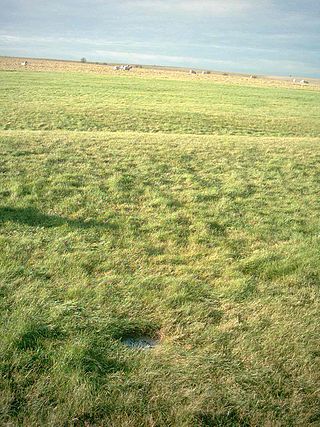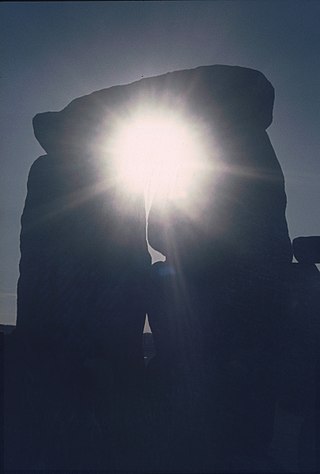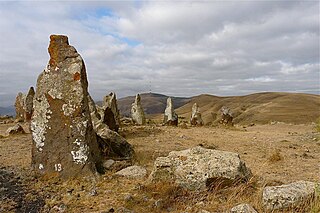
Stonehenge is a prehistoric monument on Salisbury Plain in Wiltshire, England, two miles (3 km) west of Amesbury. It consists of an outer ring of vertical sarsen standing stones, each around 13 feet (4.0 m) high, seven feet (2.1 m) wide, and weighing around 25 tons, topped by connecting horizontal lintel stones. Inside is a ring of smaller bluestones. Inside these are free-standing trilithons, two bulkier vertical sarsens joined by one lintel. The whole monument, now ruinous, is aligned towards the sunrise on the summer solstice. The stones are set within earthworks in the middle of the densest complex of Neolithic and Bronze Age monuments in England, including several hundred tumuli.

A bolide is normally taken to mean an exceptionally bright meteor, but the term is subject to more than one definition, according to context. It may refer to any large crater-forming body, or to one that explodes in the atmosphere. It can be a synonym for a fireball, sometimes specific to those with an apparent magnitude of −14 or brighter.
Tollmann's bolide hypothesis is a hypothesis presented by Austrian palaeontologist Edith Kristan-Tollmann and geologist Alexander Tollmann in 1994. The hypothesis postulates that one or several bolides struck the Earth around 7640 ± 200 years BCE, and a much smaller one approximately 3150 ± 200 BCE. The hypothesis tries to explain early Holocene extinctions and possibly legends of the Universal Deluge.
Dr. Alexander Tollmann was an Austrian professor of geology.
Souterrain is a name given by archaeologists to a type of underground structure associated mainly with the European Atlantic Iron Age.

Alexander Thom was a Scottish engineer most famous for his theory of the Megalithic yard, categorisation of stone circles and his studies of Stonehenge and other archaeological sites.

The Aubrey holes are a ring of fifty-six (56) chalk pits at Stonehenge, named after the seventeenth-century antiquarian John Aubrey. They date to the earliest phases of Stonehenge in the late fourth and early third millennium BC. Despite decades of argument and analysis, their purpose is still unknown, although an astronomical role has often been suggested.
Harry Aubrey Woodruff Burl HonFSA Scot was a British archaeologist best known for his studies into megalithic monuments and the nature of prehistoric rituals associated with them. Before retirement he was Principal Lecturer in Archaeology, Hull College, East Riding of Yorkshire. Burl received a volume edited in his honour. He was called by The New York Times, "the leading authority on British stone circles".
Gerald Stanley Hawkins was a British-born American astronomer and author noted for his work in the field of archaeoastronomy. A professor and chair of the astronomy department at Boston University in the United States, he published in 1963 an analysis of Stonehenge in which he was the first to propose that it was an ancient astronomical observatory used to predict movements of the sun and moon, and that it was used as a computer. Archaeologists and other scholars have since demonstrated such sophisticated, complex planning and construction at other prehistoric earthwork sites, such as Cahokia in the United States.
The megalithic yard is a hypothetical ancient unit of length equal to about 2.72 feet (0.83 m). Some researchers believe it was used in the construction of megalithic structures. The proposal was made by Alexander Thom as a result of his surveys of 600 megalithic sites in England, Scotland, Wales and Brittany. Thom also proposed the megalithic rod of 2.5 megalithic yards, or on average across sites 6.77625 feet. As subunits of these, he further proposed the megalithic inch of 2.073 centimetres (0.816 in), one hundred of which are included in a megalithic rod, and forty of which composed a megalithic yard. Thom applied the statistical lumped variance test of J.R. Broadbent on this quantum and found the results significant, while others have challenged his statistical analysis and suggested that Thom's evidence can be explained in other ways, for instance that the supposed megalithic yard is in fact the average length of a pace.
The Taurids are an annual meteor shower, associated with the comet Encke. The Taurids are actually two separate showers, with a Southern and a Northern component. The Southern Taurids originated from Comet Encke, while the Northern Taurids originated from the asteroid 2004 TG10, possibly a large fragment of Encke due to its similar orbital parameters. They are named after their radiant point in the constellation Taurus, where they are seen to come from in the sky. Because of their occurrence in late October and early November, they are also called Halloween fireballs.

Nabta Playa was once a large internally drained basin in the Nubian Desert, located approximately 800 kilometers south of modern-day Cairo or about 100 kilometers west of Abu Simbel in southern Egypt, 22.51° north, 30.73° east. Today the region is characterized by numerous archaeological sites. The Nabta Playa archaeological site, one of the earliest of the Egyptian Neolithic Period, is dated to circa 7500 BC.

The prehistoric monument of Stonehenge has long been studied for its possible connections with ancient astronomy. The site is aligned in the direction of the sunrise of the summer solstice and the sunset of the winter solstice. Archaeoastronomers have made a range of further claims about the site's connection to astronomy, its meaning, and its use.

The Parque Arqueológico do Solstício, referred to in academic sources as AP-CA-18, is an archaeological park located in Amapá state, Brazil, near the city of Calçoene. It contains a megalithic stone circle, colloquially known as the Amazon Stonehenge, consisting of 127 blocks of granite, each up to 4 meters tall, standing upright in a circle measuring over 30 meters in diameter at the bank of the Rego Grande river on a hilltop. Archaeologists believe that this site was built by indigenous peoples for astronomical, ceremonial, or burial purposes, and likely a combination. The function of this megalithic site is unknown, much like other sites such as Stonehenge, a much older site in Great Britain.
Umm al Binni lake is a mostly dry lake within the Central Marshes in Maysan Governorate in southern Iraq. The 3.4 km (2.1 mi) wide lake is approximately 45 km (28 mi) northwest of the Tigris–Euphrates confluence. Because of its shape, location, and other details, it was first conjectured by Sharad Master, a geoarchaeologist, to represent an impact crater. However, these claims have been disputed, with other studies finding subsidence of the underlying rock a more plausible explanation.

Carahunge, also known as Zorats Karer, Dik-Dik Karer, Tsits Karer and Karenish, is a prehistoric archaeological site near the town of Sisian in the Syunik Province of Armenia. It is also often referred to in international tourist lore as the "Armenian Stonehenge".
Some approaches in the branch of historic metrology are highly speculative and can be qualified as pseudoscience.

The stone circles in the British Isles and Brittany are a megalithic tradition of monuments consisting of standing stones arranged in rings. These were constructed from 3300 to 900 BCE in Britain, Ireland and Brittany. It has been estimated that around 4,000 of these monuments were originally constructed in this part of north-western Europe during this period. Around 1,300 of them are recorded, the others having been destroyed.
Edith Kristan-Tollmann nee Edith Kristan was an Austrian geologist and paleontologist. A prolific scientist with an interest in micropalaeontology and especially the foraminifera of the Triassic and the Jurassic eras, Kristan-Tollmann published widely in her field. She is also known for originating with her husband Alexander Tollmann a thoroughly documented theory of the evolution of human legend and social structures as a result of a massive impact event which struck multiple points on earth. The latter has become known as Tollmann's hypothetical bolide.
Terence Meaden is an English author who writes on archaeoastronomy, mostly focusing on the megalithic sites of Avebury, Stonehenge and the Drombeg stone circle in Cork, Ireland. He is a retired physicist with a doctoral degrees in physics from the University of Oxford and a master's degree in applied landscape archaeology also from University of Oxford. Meaden is influenced by the work of archaeologist Marija Gimbutas who wrote about the Goddess worshipping Neolithic and Bronze Age cultures of "Old Europe".









